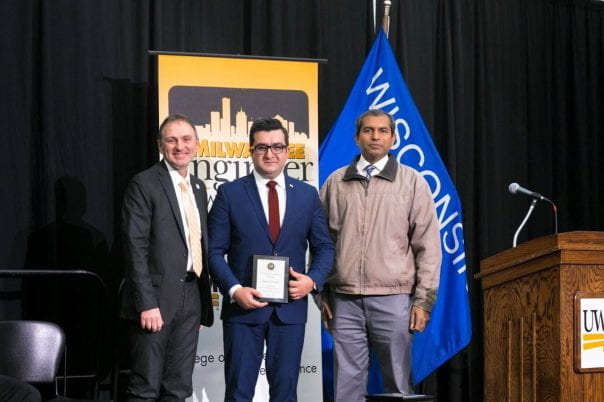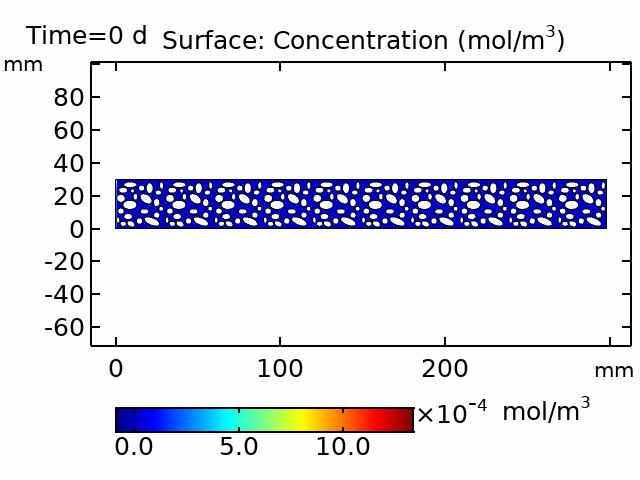Latest news:
1- Prof. Krishna Pillai, from the College of Engineering & Applied Science, has been recognized among the world’s top 2% of researchers, according to the Stanford-Elsevier global ranking, which evaluates researchers based on the citation impact of their published work, giving a gauge of their impact on their respective fields. Read more
1- Prof. Pillai was invited to deliver a keynote address on the topic of permeability and chair three sessions at ICCM 24 (24th International Conference on Composite Materials), Baltimore MD, Aug 4-8, 2025.
2- Prof. Pillai received funding from the U.S. D.O.E. Idaho National Laboratory to help in modeling of oxidative degradation of porous graphite inside a nuclear reactor. Read more
3- PhD candidate Hasan has been awarded the Student Excellence Award by UWM Student Involvement. He is one of only three recipients in the Outstanding Graduate Student category. The award honors his exceptional academic performance, research contributions, and leadership on campus. Read more
4- PhD candidate Abul Borkot Md Rafiqul Hasan has been selected as a 2025 Student Research Scholar by the Northwestern Mutual Data Science Institute (NMDSI). He will be working on modeling of uranium flushing in contaminated groundwater using machine learning. This interdisciplinary research is a collaboration with Professor Charles Paradis (Geosciences, UWM) and Professor Sheikh Iqbal Ahamed (CS, Marquette University). The award supports innovative, data-driven research and fosters cross-campus collaboration. Read more
5- PhD candidate Abul Borkot Md Rafiqul Hasan won 1st place in UWM’s 2025 Three Minute Thesis (3MT) Competition, besting over 20 doctoral students. Read more
6- PhD Candidate Abul Hasan won the prestigious Distinguished Dissertation Fellowship (DDF) awarded by UWM Graduate School for 2025-2026 . This is a highly selective award given to 15-20 students out of 4500-5000 odd graduate students at our university.
7- Next-Generation Volatile Dispenser Filed for Provisional Patent by UWMRF, Developed by Professor Pillai and Graduate Student Abul Borkot Md Rafiqul Hasan, Featured by College of Engineering and Applied Sciences.
8- PhD student Abul Hasan won the prestigious Distinguished Graduate Student Fellowship (DGSF) awarded by UWM Graduate School for 2024-2025 . This is a highly selective award given to 15-20 students out of 4500-5000 odd graduate students at our university.
9- In collaboration with the Advanced Cement Laboratory at UWM, we conducted a study on modeling the infusion of water into ceramic materials, both with and without hydrophobic coatings on it. Our research findings have been published in Scientific Reports – Nature., Link to the article. .
10- Professor Pillai was invited in June 2023 to join as an editorial board member of the newly created journal ‘Interpore Journal’, which he accepted. This journal is fully owned and operated by the most prominent international society for research in porous media, the ‘InterPore’.
11- Abul Borkot Md Hasan, a Ph.D. student of Prof. Pillai, won first prize in the CEAS poster competition held at UWM in the spring of 2023.
12- Aman Raizada, who completed MS under Prof. Pillai, was accepted into the Ph.D. program of Stanford in 2021
13- Prof. Krishna M. Pillai, a prominent researcher in the field of “Flow and Transport through Porous Media,” has been nominated to be among the top 2% of scientists worldwide.59 UWM scientists ranked in top 2% globally
14- Amin Zarandi, an ex-PhD student of Prof. Pillai, received the Academic Excellence Award 2019 from UWM College of Engineering and Applied Sciences
Numerical simulation depicting dynamic infusion of moisture into a porous ceramic tile. This numerical simulation utilized the Richards equation, a commonly employed mathematical model for analyzing water distribution in the vadose zone. COMSOL Multiphysics, a software based on the finite element method, was employed to conduct the simulation.
Numerical simulation illustrating the evolution of arsenic concentration in an adsorptive porous filter cartridge with respect to time [t = 0 day(s) to t = 300 days(s)]. The simulation employs the micro-macro coupling physics based on Whitaker’s closure formulation as used in the mathematically-rigorous volume averaging method.
Simulation of drying of a porous medium using our in-house developed code PORODRY after coupling the inside and outside flows. The simulation uses the pore network model based on Prat’s invasion-percolation algorithm and includes the film effect.
Evolution of partial saturation during mold filling of a car hood simulated by our in-house developed code POREFLOW. It uses our dual-scale model for including the unsaturated-flow physics occurring near the flow front in the woven or stitched fabrics used in resin transfer molding (RTM) for making polymer matrix composites.
Studying the effect of microstructure of a porous medium on wicking of liquids. Simulation was done using Fluent while the random microstructure was generated using GeoDict.
Water Filtration Group:
Led by Prof. Pillai, the Water Filtration Group aims to enhance water filtration processes using porous media. We combine theory, computation, and experimentation to develop innovative methods. Collaborating with global partners, we strive to improve water quality. Learn more on our website.




